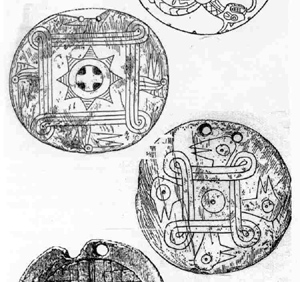
Cox Mound Gorget
The Cox Mound, or Woodpecker, gorget style is a particularly beautiful and enduring symbol of Tennessee’s prehistoric inhabitants. A gorget was a pendant, or personal adornment, worn around the neck as a badge of rank or insignia of status and was thought to be symbolic of both earthly and supernatural powers. A variety of gorget styles, or designs, are known. As a class of artistic expression, this type of artifact falls within the Southeastern Ceremonial Complex, formerly known as the Southern Cult.
Just over thirty Cox Mound-style gorgets have been found since the late nineteenth century, primarily from prehistoric Mississippian stone box graves and villages along the lower Tennessee, Cumberland, Duck, Harpeth, and Buffalo Rivers of Middle Tennessee, and the middle Tennessee River valley of northern Alabama. As a result of the frequent mortuary association of Cox Mound gorgets with certain pottery types, namely Matthews Incised, as well as other artifacts, it has been postulated that Cox Mound gorgets date to the period A.D. 1250-1450. One rich grave from the famous burial mound at the Castalian Springs site in Sumner County produced two Cox Mound gorgets.
Typically, Cox Mound gorgets were manufactured on exotic marine shell and were white in color. Other materials, such as black slate in Putnam County and human skull fragments in Hardin County, were used rarely. Engraving the intricate design on the hard shell or slate without metal tools took many hours of skilled labor and is thought to have been a winter activity.
A Cox Mound gorget has three important iconographic elements. In the center is a cross inside a rayed circle or sun motif. The cross is symbolic of the sacred, or council, fire. The sun represents the sky deity and/or mythical ancestors. Surrounding the cross and sun is a scroll-like design element known as the looped square. This feature may represent wind, or possibly the litter on which subordinates carried a chief. Typically the looped square is composed of four lines, but in some cases only three lines are used. Four crested bird heads, which most scholars interpret as woodpeckers, are found on the outer edge. The woodpecker heads always are oriented in a counterclockwise direction, suggestive of the prehistoric Native American swastika.
The woodpecker, like the falcon, was probably a symbol of war to the prehistoric Mississippian Indians. The war symbolism of the bird probably derived from the red head of the bird, which resembled a bloodied scalping victim. The Cherokees associated the red-headed woodpecker with danger and war, and the woodpecker was always invoked for aid by the ball game players. The bird’s pecking is similar to an Indian warrior striking the war post at the Victory dance. For the Cherokees, the color red is associated with male attractiveness and fertility, as well as bravery and war. Groups of woodpeckers are thought to be a sign of war to the Creeks and Seminoles. While war is typically associated with males in Native American society, it is important to note that Cox Mound gorgets have been found in both male and female burials.
Other interpretations include the identification of the four woodpeckers as the four thunders at the world quarters, and a folklorist has speculated recently that the Cox Mound gorget style is a prehistoric expression of the Yuchi myth of the Winds. Cox Mound gorgets are displayed by the Tennessee State Museum and Pinson Mounds State Archaeological Area.
Suggested Reading
C. Andrew Buchner and Mitchell R. Childress, “A Southeastern Ceremonial Complex Gorget from Putnam County, Tennessee,” Tennessee Anthropological Association Newsletter 16.6 (1991): 1-4; Madeline Kneberg, “Engraved Shell Gorgets and Their Associations.” Tennessee Archaeologist 15.1 (1959): 1-39



